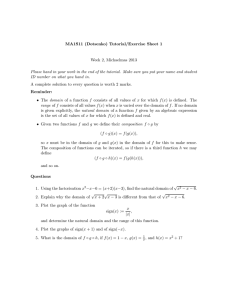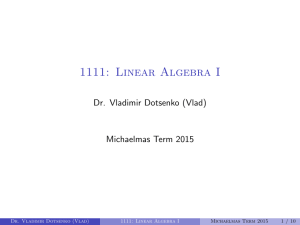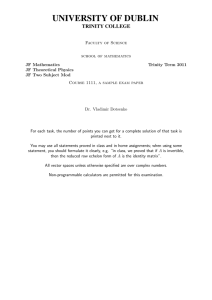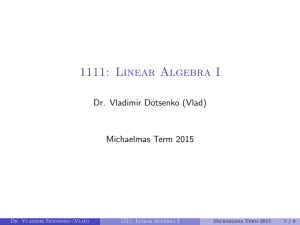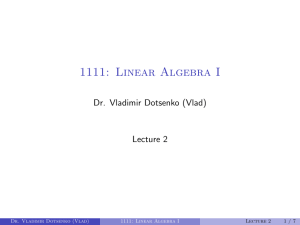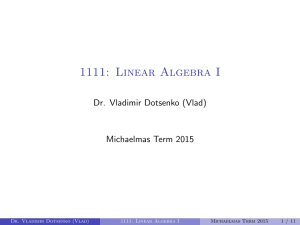1111: Linear Algebra I Dr. Vladimir Dotsenko (Vlad) Michaelmas Term 2015
advertisement
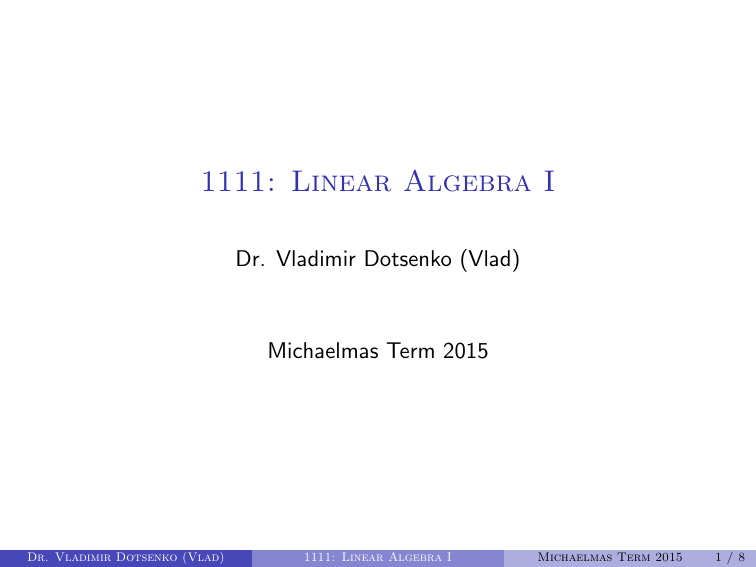
1111: Linear Algebra I Dr. Vladimir Dotsenko (Vlad) Michaelmas Term 2015 Dr. Vladimir Dotsenko (Vlad) 1111: Linear Algebra I Michaelmas Term 2015 1/8 Towards computing determinants In school, you may have seen either the formula d −b −1 ad−bc ad−bc A = −c a ad−bc for a 2 × 2-matrix A = ad−bc a b , or at least its consequence, the formula c d ( x= y= de−bf ad−bc , af −ce ad−bc , allowing to solve a system of two equations with two unknowns ( ax + by = e, cx + dy = f . Now, we shall see how to generalise these formulas for n × n-matrices. Dr. Vladimir Dotsenko (Vlad) 1111: Linear Algebra I Michaelmas Term 2015 2/8 Permutations To proceed, we need to introduce the notion of a permutation. By definition, a permutation of n elements is a rearrangement of numbers 1, 2, . . . , n in a particular order. For example, 1, 3, 4, 2 is a permutation of four elements, and 1, 4, 3, 4, 2 is not (because the number 4 is repeated). We shall also use the two-row notation for permutations: a permutation of n elements may be represented by a 2 × n-matrix made up of columns j , where aj is the number at the j-th place in the permutation. aj For the permutation 1, 3, 4, 2 may by the matrix example, be represented 1 2 3 4 1 4 3 2 , but also by the matrix , and by many other 1 3 4 2 1 2 4 3 matrices. Incidentally, the number of different permutations of n elements is equal to 1 · 2 · · · n, this number is called “n factorial” and is denoted by n! (n with an exclamation mark). Dr. Vladimir Dotsenko (Vlad) 1111: Linear Algebra I Michaelmas Term 2015 3/8 Odd and even permutations Let σ be a permutation of n elements, written in the one-row notation. Two numbers i and j, where 1 ≤ i < j ≤ n, are said to form an inversion in σ, if they are “listed in wrong order”, that is j appears before i in σ. For the permutation 1, 3, 4, 2, there are 6 pairs (i, j) to look at: (1, 2), (1, 3), (1, 4), (2, 3), (2, 4), (3, 4). Of these, the pair (2, 3) forms an inversion, and the pair (2, 4) does, and other pairs do not. A permutation is said to be even if its number of inversions is even, and odd otherwise. One of the most important properties of this division into even and odd is the following: if we swap two numbers in a permutation a1 , . . . , an , it makes an even permutation into an odd one, and vice versa. Let us first remark that this is obvious if we swap two neighbours, ap and ap+1 . Indeed, this only changes whether they form an inversion or not, since their positions relative to others do not change. Now, a swap of ap and aq can be done by dragging ap through ap+1 , . . . , aq−1 , swapping it with aq , and dragging aq through aq−1 , . . . , ap+1 , so altogether we do an odd number of “swapping neighbours”. Dr. Vladimir Dotsenko (Vlad) 1111: Linear Algebra I Michaelmas Term 2015 4/8 Odd and even permutations The property that we just proved is useful for a yet another definition of even / odd permutations that refers to the two-row notation. Namely, a permutation in two-row notation is even if the total number of inversions in the top and the bottom row is even, and is odd, if the total number of inversions in the top and the bottom row is odd. The usual problem to address is whether this definition makes sense or not: maybe it will give different answers for different two-row representations. Luckily, it is not the case: different representations are obtained from one another by re-arranging columns, and each swap of columns will change the number of inversions in the top row and in the bottom row by odd numbers, so altogether will give a change by an even number. For example, the two different representations of 1, 3, 4, 2, that we 1 2 3 4 discussed, everything works: for , the total number of 1 3 4 2 1 4 3 2 inversions is 2 and for the total number of inversions is 1 2 4 3 3 + 1 = 4. Dr. Vladimir Dotsenko (Vlad) 1111: Linear Algebra I Michaelmas Term 2015 5/8 Determinants We shall now define an important numeric invariant of an n × n-matrix A, the determinant of A, denoted det(A). Informally, the determinant of A is the signed sum of all possible products of n entries of A, chosen in a way that every row and every column is represented in the product exactly once. Formally, det(A) = X sign(σ)Ai1 j1 Ai2 j2 · · · Ain jn . σ i1 i2 . . . in Here σ runs over all permutations of n elements, and is j1 j2 . . . jn some two-row representation of σ. The sign sign(σ) of a permutation σ is defined to be 1 if σ is even, and −1 if σ is odd. Dr. Vladimir Dotsenko (Vlad) 1111: Linear Algebra I Michaelmas Term 2015 6/8 Properties of determinants Let me list some properties of determinants that we shall eventually prove. Even before we prove them, you can use them in calculations without proof. If three matrices A, A0 , and A00 have all rows except for the i-th row i in common, and the i-th row of A is equal to the sum of the i-th rows of A0 and A00 , then det(A) = det(A0 ) + det(A00 ); if two matrices A and A0 have all rows except for the i-th row in common, and the i-th row of A0 is obtained from the i-th row of A by multiplying it by a scalar c, then det(A0 ) = c det(A); if two matrices A and A0 have all rows except for the i-th and the j-th row in common, and A0 is obtained from the A by swapping the i-th row with the j-th row, then det(A0 ) = − det(A); if two matrices A and A0 have all rows except for the i-th row in common, and the i-th row of A0 is obtained from the i-th row of A by adding a multiple of another row, then det(A0 ) = det(A); for each n, we have det(In ) = 1. Dr. Vladimir Dotsenko (Vlad) 1111: Linear Algebra I Michaelmas Term 2015 7/8 Properties of determinants Effectively, these properties say that - determinants are multilinear functions of their rows, - determinants behave predictably with respect to elementary row operations. Let us give an example of how this can be used: 1 2 2 1 2 2 (2)−(1),(3)−(1) det(1 1 4) = det(0 −1 2) = 1 2 8 0 0 6 1 2 2 1 (2)+2(3),(1)−2(3) (−1) · 6 · det( 0 1 −2 ) = −6 det( 0 0 0 1 0 1 − 6 det(0 0 Dr. Vladimir Dotsenko (Vlad) 1111: Linear Algebra I 2 0 (1)−2(2) 1 0) = 0 1 0 0 1 0) = −6. 0 1 Michaelmas Term 2015 8/8


